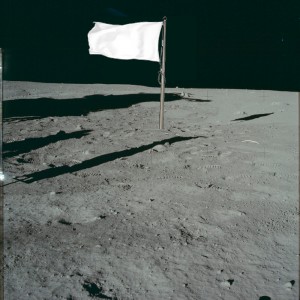Faded Flags on the Moon
The probable current state of the Apollo American flags on the Moon: Symbolic?
Today is the 42nd anniversary of man’s landing on the Moon. The first step on the Moon – the step that “divided history” to use the words of the time – and the planting of the American flag there seems like a lifetime ago. As a matter of fact, it was.
Tomorrow, the Space Shuttle Atlantis will land back at its launch site, ending that program’s 30-year tenure as the centerpiece of America’s space program. That was not a lifetime ago, but a similar sense of loss is evident.
In both cases, the end of a mission series brought upheaval to the space program, as thousands of workers lost their jobs, sold their homes and moved on but not before helping to write an important chapter in America’s history. The end of the Shuttle program and the dismantling of Shuttle infrastructure at Florida’s Cape parallels the dismantling of our national space program.
Ending this major U.S. space program is not like finishing a highway construction project or a bridge, where skilled workers go on to other construction projects. The people that launched Saturn and Shuttle were highly trained – acquiring expert knowledge through years of experience. They cannot be found on the street, but must be carefully assembled and made into a team, trained in their specific specialties, and tested in actual flight experience.
Unlike the end of Apollo, the end of Shuttle finds uncertainty in our national direction in space. Despite the cawing of the flock of “new direction” supporters, a stunning realization is just now sinking in to a bewildered American public: we’re discarding a national capability with no successor – no strategic direction, no vehicle, no path forward. Not even a “flexible” one.
Seven years ago, a positive direction in space was articulated as the Vision for Space Exploration (VSE). In short, it called for the gradual extension of human reach beyond low Earth orbit, starting with a return to the Moon, followed by trips to destinations beyond, including Mars. Despite misinformation in the press, the Vision was not (and still is not) “unaffordable” – its affordability depends on its implementation.
The implementation of the VSE by NASA was predicated on the assumption that the Apollo approach was the best way to establish a new space faring capability. Although such an assumption could be argued, it had the virtue of having an existence proof in that we had done it that way before. A drawback to such an approach is that it opened the program to the criticism that lunar return under the VSE was merely a repeat of Apollo, a canard that wasn’t true then or now.
When Constellation ran into the developmental problems and extra costs that all new programs experience, national leaders became concerned. This concern emanated not from the money being spent (the federal government spends more in 8 hours than NASA spends in a year); the concern was that this new effort appeared to be in support of a “repeat” of Apollo. With few exceptions, most people had never heard the objective of using the Moon to create new space faring capability. Instead, the public repeatedly heard the trite and dismissive “been there, done that” mantra and “We already have six American flags on the Moon,” to quote one notable. And that mischaracterization of the Vision manifested our current direction, i.e., one of no direction.
We discarded both a working transportation system and a strategic path forward in space in exchange for promises of commercial space travel to LEO and dreams of human missions to an asteroid (with nebulous rationale and timetable). Wishing new capabilities into existence without a clear step-by-step path forward would be laughable if it wasn’t so tragic. The administration came to a fork in the road, pondered the direction our national space program could go, and chose a path with no objective or productive program architecture that America could embrace to stay on top of her game.
Over the course of the Apollo program, our astronauts deployed six American flags on the Moon. For forty-odd years, the flags have been exposed to the full fury of the Moon’s environment – alternating 14 days of searing sunlight and 100° C heat with 14 days of numbing-cold -150° C darkness. But even more damaging is the intense ultraviolet (UV) radiation from the pure unfiltered sunlight on the cloth (modal) from which the Apollo flags were made. Even on Earth, the colors of a cloth flag flown in bright sunlight for many years will eventually fade and need to be replaced. So it is likely that these symbols of American achievement have been rendered blank, bleached white by the UV radiation of unfiltered sunlight on the lunar surface. Some of them may even have begun to physically disintegrate under the intense flux.
America is left with no discernible space program while the Moon above us no longer flies a visible U.S. flag. How ironic.
/https://tf-cmsv2-smithsonianmag-media.s3.amazonaws.com/accounts/headshot/blog_headshot_spudis-300x300.jpg)

/https://tf-cmsv2-smithsonianmag-media.s3.amazonaws.com/accounts/headshot/blog_headshot_spudis-300x300.jpg)